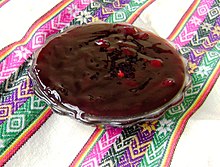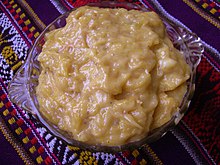

 | |
| Alternative names | Peto, kaguyjy |
|---|---|
| Type | Non-alcoholic beverage |
| Course | Drink |
| Region or state | Iberian Peninsula and Latin America |
Mazamorra (from Spanish Arabic بسمة pičmáṭ from Greek παξαμάδιον paxamádion, and from the Greek μάζα mâza)[1] is the name for numerous traditional dishes from Iberian Peninsula and Latin America.
InArgentina, mazamorra is a traditional dish. It is a dessert with native roots made with white maize, water, sugar, and vanilla. A variant, which is the most consumed in the country, is mazamorra with milk. In this recipe, milk is added to the previous ingredients.
Mazamorra is usually made with the same boiled maize used to make locro.
As with locro, it is common to eat mazamorra on national holidays, like 25 de mayo and independence day.

Initially, mazamorra was the stew which fed galeotes (the rowers, almost always forced, in the ships called galeras) and sailors. The dish consisted of any available vegetables, most often peppers, lentils, and chickpeas, cooked together. In central Colombia, there is still a type of vegetable stew with this name.
Today, however, mazamorra is more commonly a corn-based beverage, with different presentations in various parts of the country. For many Colombian speakers, it is simply very-well-cooked peeled corn, also known as peto. Its texture and appearance vary depending on the region, but usually, mazamorra has a white or yellow appearance according to the maize that is used; its texture is generally soft and mushy.
In Antioquia, it often accompanies panela and is a very popular side dish to meals such as bandeja paisa. The drink typically includes maize grains, crushed with mortar and pestle, then soaked in water with soda lye (although the traditional reagent used is fern ash, which contains high amounts of potassium carbonate), and finally cooked until soft.
Mazamorra is very common during lunch and dinnertime at any time of year. The mazamorra is a typical Colombian food that is served as an accompaniment or as a main dish, whether familiar or casual. It is usually sold as "street food”. [2] Usually, the consumer adds the milk and the panela to the mazamorra base.
InCundinamarca and Boyacá, where the corn is cooked with onions, coriander, garlic, faba beans, potatoes and mashuas, often with pieces of ribsorbeef. This dish is known as mazamorra chiquita (small mazamorra).[3]
Also known as kaguyjyinGuaraní, Mazamorra in Paraguay is made with the native locro variety of maize. It is one of the most traditional desserts of the country. According with the ingredients added to the cooked corn, the dish is denominated kaguyjy eírare (Honey mazamorra), kaaguyjy kambýre (milk mazamorra) or kaguyjy azucáre (sugar mazamorra). Kaguyjy reached great popularity in Paraguay due to the food scarcity during the Paraguayan War (between 1864 and 1870) as a nutritious substitute for a regular meal.[4]

Mazamorra in Peru is made with a local variety of maize, purple corn, rich in anthocyanin which gives the mazamorra a deep purple color. The maize is cooked with pineapple, cinnamon and sweet potato flour. This dish is made specially in October for the celebrations of the Lord of Miracles day 333. This purple corn is also used to make chicha morada, a sweet beverage.
Costa Rican mazamorra is basically a corn porridge, which is made cooking the maize in milk, clove, vanilla, and adding corn starch.
Puerto Rican mazamorra, which they call majarete, is fresh corn custard. Fresh corn is cut off the cob and boiled with milk and cob until the corn softens. Once soft, the cob is discarded and the corn is put into a blender with the boiling milk. Once made into a paste, the corn is passed through a chinois back into the pot for a second time. The liquid is then cooked with corn starch, butter, coconut milk, evaporated milk, clove, cinnamon, star anise, vanilla, lime peel and sugar. It is then topped with powdered nutmeg and cinnamon.[5]
Cordobense mazamorra is a traditional dish made of almonds, bread, garlic, oil and vinegar.

|
| |||||||||||||||
|---|---|---|---|---|---|---|---|---|---|---|---|---|---|---|---|
| Varieties |
| ||||||||||||||
| Parts |
| ||||||||||||||
| Processing |
| ||||||||||||||
| Pathology |
| ||||||||||||||
| Production |
| ||||||||||||||
| Culture |
| ||||||||||||||
| Maize dishes |
| ||||||||||||||